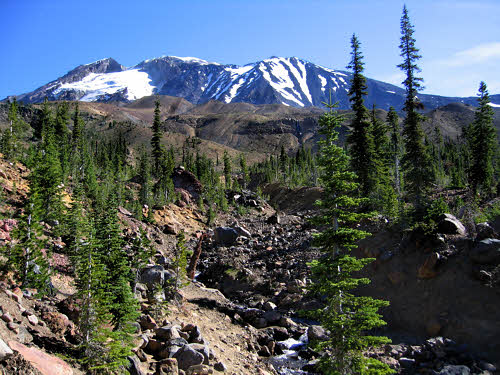More photos from the past. And more to follow.
St Helens (click to embiggen)
These photos are from the third day of one of my trips around Mt Adams in the south Cascade Mountains of Washington State. I think this has to be my favorite trip ever. I'll have a bunch more photos later.
Rainier (click to embiggen)
But right now, let's enjoy summer weather, if only in images.
Round the Mountain Trail (pano: click to embiggen)
The west side of Adams is pretty lush. Not like rain forest terrain, but well-watered. Mt Hood in northern Oregon is similar, but different. The trail around Adams is pretty level and easy (except for a part we'll get to in a later post). The high point at Mt Hood is about 7800 feet (2377 m), and there is more up and down. Adams is pretty level.
Horizon, St Helens to Rainier (pano: click to embiggen)
After a short first day and a mellow first night on the western side of the mountain, you continue (if going counter-clockwise) in deep forest for a while. Streams are common but not too frequent. There are no wet crossings, at least in August, which is always nice. You also get good views of St Helens to the southwest, as well as diminishing sightings of Mt Rainier to the northwest.
Mt Hood (pano: click to embiggen)
Gradually, Rainier disappears into the trees while St Helens becomes more prominent, and then, if you're watching for it, you realize you can see pointy Mt Hood. This is always a treat. Adams is pretty blunt. St Helens is truncated, dusty, and still smoky. But Hood is a spike on the skyline, always distinctive.
South side of Adams
Sure, Rainier is quite distinctive too, but in its own class - much, much larger than any of the other volcanoes in this area, with a more complex profile, nothing like the clean, simple Hood..
South Adams - getting dry (pano: click to embiggen)
Eventually, coming to the more southern side of Adams, you notice that you have views of broad valleys toward the south. The forest changes slowly, and if you have a calm day, you might start feeling a little too hot. This is a fine time to stop for lunch. Hop off the trail and out of sight, find some clean bare soil, and settle in on a level shelf above the trail, enjoying both privacy and 180-degree views of the surrounding landscape. Given the right choice of location you can have enough shade to be comfortable too.
Mt Hood (pano: click to embiggen)
Unlike the south side of Mt Hood, where be ski areas, a lodge, late-season snowboarders, and tourists, at Adams there is only trail and trees. I've been 'round the mountain twice and have seen almost no other people. Just after passing the southernmost side of the mountain and coming into the southeast you see a sign welcoming you to Yakima tribal land. I don't know much about this area, except that I've seen signs indicating that there might be a picnic area somewhere below. You also see day hikers who drive into the Reservation, park, and hike up to an overlook. We'll see that next time.
Typical late summer foliage
For me, this is the time to find my second campsite. Hey, why push it? This trail is massively enjoyable, all too short, and the third day is a killer, so this is a good time to camp, and a great area for it. The first time I did this trip (the photos here) I found an absolutely amazing hidden campsite. Not a campsite, for one thing. Completely out of sight, well above the trail, on a sandy flat, and with its own stream. The foliage picture is from a spot where a similar little stream crosses the trail.
Southeast Adams - the driest side (pano: click to embiggen)
Luckily, I'm a doofus. I wanted to stay well out of sight, though there were almost no people around. It's kind of my thing. I took a left turn off the trail and noodled upslope through the trees, thinking of giving up with every step. But, since I really am a doofus, I kept going. And kept on after that. And after that. And then there was this little circular open area about 40 feet (12m) across. Flat, sandy, with good hammock trees. And then the killer feature. Down a small bank there was another flat, all grassy, and then my own little clear, clean stream of water. Bingo.
Morning, Mt Hood from my bedroom (pano: click to embiggen)
I had a great, quiet night, all clean from a bath, plenty of water to drink, and for cooking, my choice of good places to hang food, and it was all fine. The next morning when I got up the sun was out again, and going over to my "bedroom window" I realized that I had a fantastic panoramic view southeast into the dry center of Washington State, and stretching all the way around to the west, where I could still see Mt Hood. OK by me.
Previously: Adams West

























